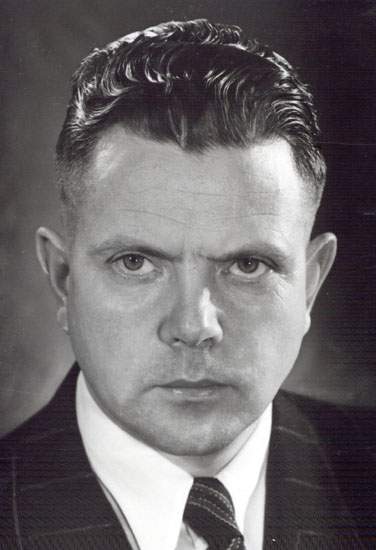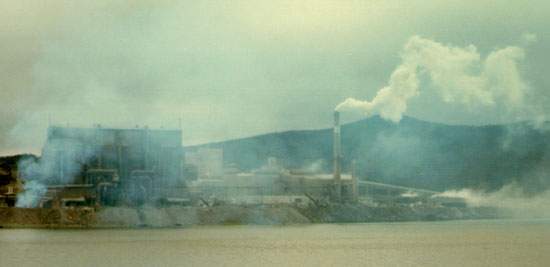Electrifying the Island
At the time of Confederation in 1949 slightly over half of the province's population used electricity. The existing generating stations were not capable of greatly increasing their capacity. Smallwood promised the electrification of rural areas, and it was necessary to increase the number of generating stations. Areas were served either by utility companies or, in the case of Grand Falls and Corner Brook, by the pulp and paper companies. To extend electrification to rural areas the government created the Newfoundland Power Commission in 1954. Between 1954-1972 almost every Newfoundlander on the island was receiving electricity.
Hydro-Electric Power
In the 1949 election campaign Smallwood promised voters his government would develop local hydro resources as "cheap power is the foundation of any industry. Grand Falls and Corner Brook would never have amounted to anything without lots of cheap power. Newfoundland has been blessed with great water power. Most of it is running to waste." (Evening Telegram, 16 May 1949) Upon becoming premier Smallwood continued his focus on hydro, using the lure of cheap power to woo industrialists. From 1950 to 1953 Alfred Valdmanis, Newfoundland's Director-General of Economic Development, attempted to attract German technical expertise and capital to Newfoundland and Labrador to develop hydro potential on the Bay d'Espoir and Grand Le Pierre rivers. Smallwood wanted to build two new pulp and paper mills, one in Bay d'Espoir, the other in Labrador and needed the timber and cheap power from the Hamilton River (renamed the Churchill River in 1965) to make the project economically feasible.

In 1952 Smallwood, Valdmanis and Attorney General Leslie Curtis flew to London and announced that Newfoundland and Labrador were open to development, especially their hydro resources. At the culmination of the trip, Smallwood met with businessmen who were to later form the British-Newfoundland Company (Brinco). Newfoundland Light and Power was also interested in developing Bay d'Espoir in the early 1960s, and power was needed to meet the anticipated needs of a proposed aluminum plant on the south coast.
Having reorganized the Power Commission, the province undertook its first major publicly-owned hydro-electric project in the mid-1960s at Bay d'Espoir. The project was built to provide low-cost power which would help extend the island's utility services and provide an incentive to attract new industries. The Power Commission also planned an island-wide transmission grid to connect all generating and distribution facilities.
The government's "cheap power" policy only attracted one new company, Electric Reduction Company of Canada (ERCO), producing elemental phosphorus, to Newfoundland and Labrador, though cheap power was also promised to the two pulp and paper companies, whose own power stations were unable to meet their needs. In addition, ERCO also took advantage of federal and provincial subsidies to locate in Newfoundland and Labrador.
Expenditures
Justifying the power subsidy, the Newfoundland and Labrador government stated that, overall, the government would receive more in taxes and other benefits than it paid in subsidies. Budget speeches in 1969 and 1970 anticipated that from 1967 to 1986 seven new industries would benefit from the cheap power subsidies - an oil refinery and pulp and paper mill at Come by Chance, a linerboard mill, saw mill and hockey stick plant in Stephenville, a forest products plant at Hawkes Bay and the elemental phosphorus plant at Long Harbour - and would net the treasury over $180 million. Only the linerboard mill and the oil refinery became operational for more than a year, the refinery with a checkered history; and only the linerboard mill can properly be described as having been attracted to the province by the government's "cheap power" program.
Under its power subsidy, ERCO received power at 2.5 mills per kWh, roughly half the cost at the time, for a period of 25 years, in exchange for agreeing to locate on the Avalon Peninsula. The provincial government also provided a $15 million bond issue to help finance the mill, and the federal government provided $2 million for the road linking the mill and the local community. The federal government also provided the wharf and harbour facilities, and an additional $5 million federal grant through the Area Development Incentives Act. The incentives ultimately helped provide 550 jobs, but returns from the development were relatively small given the amount of public funding. Raw materials were largely imported from Florida, and the final product was exported to Britain. From 1968 to 1971 ERCO received over $10 million in electrical subsidies. By 1973-74 the power subsidies to ERCO and the two pulp and paper companies amounted to $6.5 million per year.

Advantages and Disadvantages
Many authors argue that rarely has a policy of cheap power on its own been enough to attract new industrial development. As the case of ERCO shows, other financial incentives were needed in addition. One argument in favour of these large projects is that they create jobs, both directly and indirectly, and in Newfoundland and Labrador the lure of jobs is strong. But it is important to look at the nature of the jobs created by these projects, and at the long-term impact of these jobs on the economy. In hydro development, most jobs are created in the construction phase of the project and are temporary. Even in the construction phase the number of jobs is limited, with a significant proportion of them demanding skills not available locally. Many supervisory and managerial positions have been filled from outside the province, and many of the more skilled construction positions. Newfoundland and Labrador workers make up a large portion of the "unskilled" and "semi-skilled" construction workforce. After construction few long-term jobs emerge as the hydro industry — and the refining and oil production industries — are capital and power intensive rather than labour intensive.
The Continuation of Electrification
Further hydro-electric generating stations were built in the 1970s and early 1980s to meet the increasing demand for electricity, including the Hinds Lake project in central Newfoundland which started construction in 1977, the Upper Salmon River project on the south coast which started construction in 1979, and the Cat Arm project on the northwest coast started in 1981. In the mid-1970s Newfoundland Light and Power also constructed an oil-fired electric generating station at Holyrood. Gas turbines were also put into place in the mid-1980s in Stephenville and St. John's. Another electric station which has been under debate since the mid-1970s is the development of the Lower Churchill. Talks about developing the Lower Churchill river continued, although a memorandum of understanding between the Québec and the Newfoundland and Labrador governments for developing the Lower Churchill collapsed.




